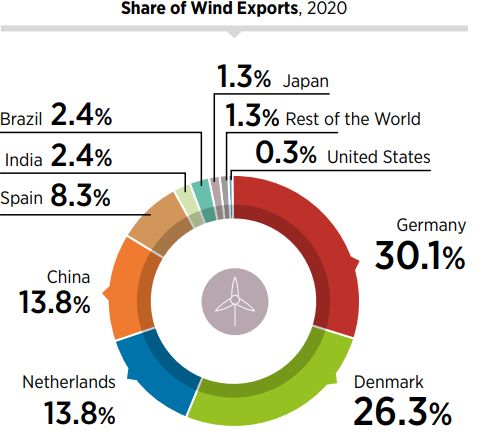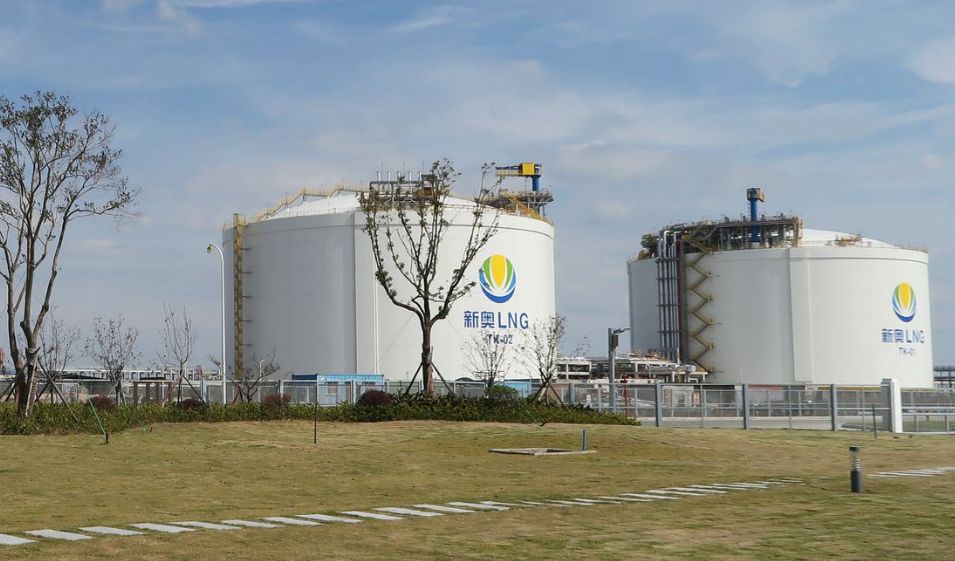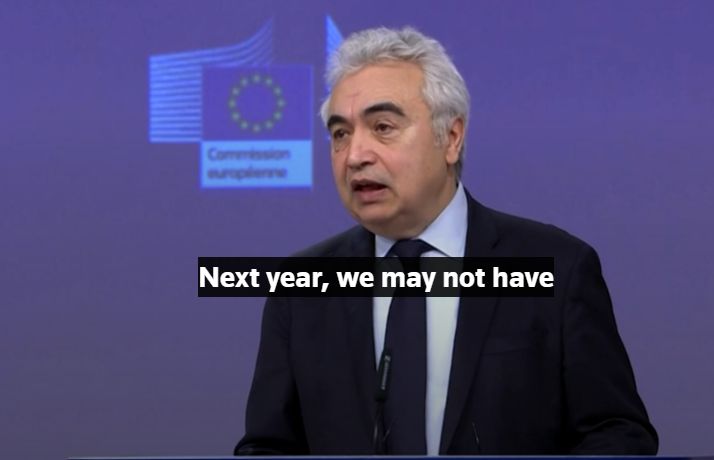By Eric Vandenbroeck
and co-workers
Renewables And Energy Security
German Chancellor Olaf
Scholz delivered his historic “Zeitenwende” –
literally, “turn of an era” – speech three days after Russia invaded Ukraine.
Scholz said the world was at an inflection point, and Berlin had to adapt.
Foremost, Germany needed a forceful but prudent answer to the Russian attack.
Scrapping his coalition’s ban on the delivery of lethal weapons to conflict
zones, Scholz announced the shipment of thousands of shoulder-fired anti-tank
and anti-aircraft weapons to Ukraine – a huge deal among German officials, though
less so among their allies. He also endorsed sanctions against Russia’s elites
and reaffirmed his government’s commitment to defending its NATO allies. Scholz
would flesh out his Ukraine policy later, but for now, he had committed Germany
to contain the war and exert pressure to bring the Kremlin back to the
negotiating table.
But what made
Scholz’s Zeitenwende speech famous were two other
commitments. First, the chancellor said Germany would “overcome” its dependence
on Russian energy. Second, he promised to transform the Bundeswehr into a
capable, modern fighting force by launching a 100 billion-euro ($106 billion)
special fund for defense projects and investments. And “from now on, year after
year,” Germany would spend more than 2 percent of its gross domestic product on
defense, he said.

Germany has undergone
a sea change regarding its energy security, though it and Europe are still far
from independent of Russia. But the stories – and the data – regarding defense
modernization and rearmament are roughly the same as before. There are some
dependencies Germany is not ready to leave behind.
Energy Security
In the spring, German
officials warned that the sudden loss of Russian gas supplies would trigger
a recession on par with 2009 when the German economy shrank 5.7 percent. Yet
the latest official estimates for 2023 assume little to no Russian gas and
still project a fall in the gross domestic product of half a percent or less.

How did this happen?
First, Europe made refilling gas storage an emergency priority. At the time of
writing, Germany’s gas storage is 88 percent full, 11 percentage points above
the five-year average for this time of year. EU storage is more than a third
higher than last year's. Second, demand destruction and conservation efforts
contributed to a 20 percent drop in EU gas consumption from August to November
relative to previous years. Germany cut its consumption by more than a quarter.
This was just as Russia was escalating the gas war, stopping delivery in September
through the Nord Stream 1 pipeline, which along with its sister project, was
sabotaged in October by unknown actors.
Finally, Germany
could only import liquefied natural gas after Russia invaded Ukraine. After the
invasion, Germany, in just ten months, built the infrastructure to host its
first floating LNG terminal. (This is a country that routinely uses fax
machines and where a capital airport project missed its deadline by nine
years.) Germany will launch two more floating LNG terminals soon, enabling it
to replace about a third of the gas it imported from Russia last year – without
needing to rely on its neighbors. More terminals will open next winter for a
total LNG import capacity of approximately 30 billion cubic meters, a little
over half what Germany bought from Russia in 2021. It’s not exactly the picture
of German efficiency – the LNG terminals are costing well over double the
government’s estimate – but by German standards, it was swiftly done,
especially for a project of this magnitude.
And of course, there
are Germany’s inherent advantages – its access to the North and Baltic seas and
its centrality in Europe, and especially its strong finances, which enable it
to compete with wealthy Asian buyers of LNG. This is why Germany was reluctant to
accept proposals for an EU price ceiling on natural gas imports. If not its
energy-intensive industry, Germany is better positioned than most of the region
to weather high gas prices. It worries that an effective cap would undermine
government efforts to reduce energy consumption while potentially diverting LNG
shipments to non-European buyers and rattling markets. On Dec. 19, Berlin
relented and supported a cap, but the myriad safeguards mean it is questionable
whether it will ever be activated.

This is not to downplay
the risks, the most immediate of which is that without adequate energy savings,
Europe could suffer blackouts. Especially vulnerable are landlocked states in
Central and Eastern Europe and anyone that can’t outbid the wealthier northwest
for gas. Mild temperatures have helped reduce consumption, and in a best-case
scenario, German gas storage could enter April more than 70 percent full. By
this time, Europe will have shifted from drawing down stockpiles to
replenishing them. However, the consensus is that restocking will be extremely
difficult for Europe next year, with Russian gas potentially unavailable and
the anticipated return of Chinese demand following the end of its zero-COVID
policy. The Paris-based International Energy Agency warned recently that the EU
could fall 27 bcm short
of meeting its estimated demand of 395 cm next year.
If worse comes to
worst, political cooperation in the EU breaks down, and gas-sharing agreements
fail, it’s safe to assume the bloc’s wealthiest member state would suffer a
smaller share of the pain. As with the economic response to COVID-19, the main
challenge for the German government will probably be balancing its narrow
national interests with its EU obligations.
Defense U-Turn
As for Scholz’s
defense spending commitments, there is no suspense. Germany will not spend 2
percent of GDP on defense in 2023, and based on current plans, after hitting
the mark in 2024-25, it will fall back below it in 2026. Scholz’s term ends in
2025, so he can campaign on (temporarily) meeting the target. Winning elections
is, ultimately, what the 2 percent target is for. The real measure of whether a
NATO member is meeting its minimum obligations is not so easily quantifiable,
but no one disputes that Germany is falling short. Early returns on the Zeitenwende are hardly better.
In a recent exercise,
all 18 new Puma infantry fighting vehicles failed. Before that, amid unsourced
reports that the Bundeswehr had ammunition for only a couple of days of the
war, the co-leader of Scholz’s Social Democrats traded blame with defense
industry officials for the shortage. The government says the industry is
failing to invest; the industry says it does not trust the government to make
investing worthwhile. Meanwhile, Defense Minister Christine Lambrecht, also of
Scholz’s party, asked the finance minister to provide funds to buy ammunition
urgently. The finance minister said Lambrecht had never mentioned this supposed
emergency before and pointedly suggested she get her own house in order. The
Finance Ministry also denied the request, which drew less attention, and said
bureaucratic hurdles were to blame.
But the real culprit
is Germany’s interests and strategy, which has not changed as much as Scholz’s Zeitenwende speech indicated. The reason is that the
catalyst for the change – the looming threat of a Russian attack on a German
ally – is no longer credible. In the last days of February, officials in
Ukraine and the West were anticipating Kyiv’s encirclement. No one knew if the
Ukrainian state would survive. No one knew how dependable the U.S. response
would be, nor even whether EU or trans-Atlantic unity would hold if the Kremlin
took any number of plausible actions, such as cutting off Europe’s gas
supplies.
Ukrainian strength
and American support have greatly exceeded expectations in Berlin and Moscow.
By April, Russian forces had withdrawn from around Kyiv. Not long after, the
grumbling started in Berlin about whether all the new defense spending was
essential. The Greens argued that more of the new 100 billion-euro special
military fund should go to non-military elements of security, such as cyber and
infrastructure protection. The cost-conscious Free Democrats felt emboldened to
make the process as painful as possible to prevent it's being repeated. And
Scholz’s own Social Democrats returned to navel-gazing. Over the summer, a
senior Social Democratic lawmaker and chair of the Bundestag’s Foreign Affairs
Committee wrote an essay outlining “a new Ostpolitik for the Zeitenwende.” This new Ostpolitik, or eastern policy, would
be everything to everyone: “realistic and value-based, underpinned by military
resilience and willingness to engage in dialogue.” And he said it should be
coordinated with some three dozen German allies, with the close involvement of
civil societies – which is good for diplomatic relations and democracy but a
recipe for inaction.
"As of the evening
of 26 December, Zelenski announced that about 9
million people are cut off in different regions of Ukraine. But the number and
duration of outages is gradually decreasing. I am grateful to every person who
ensured this result,” he said. "Today, I held a special meeting with
government officials on the energy sector and infrastructure situation. We are
preparing for the next year, not only for the winter months. Some threats must
be eliminated. There are steps to be taken. And the state will make them,"
Zelensky added
The More Things Change …
The loss of Russian
piped gas is a seismic event for Europe. Gazprom’s pipelines to Germany under
the Baltic Sea are dead and buried, and the Yamal pipeline through Belarus and
Poland isn’t operating. Shipments are occurring only via Turkey and Ukraine,
both in small quantities. As a result, European gas prices are four to five
times the norm.
But over time, the
expansion of European LNG import capacity will help globalize the LNG market,
with prices on the American, Asian and European markets converging.
Persistently high prices will also transform the European industrial landscape,
bankrupting weaker firms and driving some energy-intensive manufacturing out,
but also creating the painful conditions that tend to drive innovation. (Some
manufacturers have defied expectations and found novel ways to boost their
energy efficiency.) The crisis has renewed interest in the deepening of
European energy cooperation, and it could accelerate the discovery and
development of breakthroughs in green technology. It could also provoke social
unrest and civil strife. Or the war could end suddenly, and Russia could begin
restoring gas supplies. Only time will tell.
But regarding
security policy, Germany is still determining if it needs to do much more.
Suppose the Putin regime survives its misadventures in Ukraine. In that case,
it will still be years before it can threaten any defensive coalition Poland,
Finland, and Sweden – let alone NATO – could put together. Poland especially
has been bolstered by the war in Ukraine, and Warsaw is determined to build
Europe’s strongest army. Whether it succeeds or not, Polish power is rising
relative to Russia, providing Germany a more robust layer of protection. Most
importantly, the Biden administration is determined to provide stability and is
eager to show partners and rivals in Asia that it is a reliable and valuable
ally.
This does not mean
nothing has changed in Germany. The urgency to break the country’s reliance on
Russian piped gas is real – in fact, energy experts warn that Germany is
overbuilding LNG import capacity. Moreover, dreams of an entente with Russia
have been shattered, and Germans are more conscious of the risks of dependence
on authoritarian states. For example, 84 percent of Germans agree that it is
important that the country reduce its economic reliance on China, though the
government is divided on this. But for a while longer, the U.S. is willing to
provide the relatively minor resources necessary to stonewall Russia, which is
paying an exorbitant price in Ukraine. Until this changes, Germany is betting
against the Zeitenwende.
For updates click hompage here